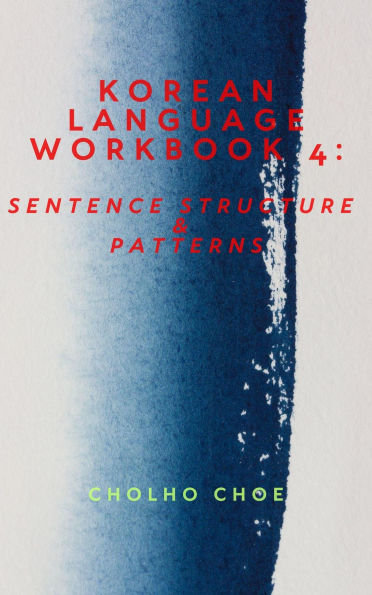Korean Language Workbook 4: Sentence Structure and Patterns
1. This book is an academic material for the acquisition of sentence patterns of Korean language.
2. This book consists of 12 UNITS:
UNIT 1. SUBJECT + ACTION VERB
UNIT 2. SUBJECT + NOUN as subject complement + STATIC VERB
UNIT 3. SUBJECT + ADJECTIVE or PRESENT PARTICLE as subject complement +STATIC VERB
UNIT 4. SUBJECT + OBJECT + VERB
UNIT 5. SUBJECT + LOCATION + STATIC or ACTION VERB
UNIT 6. SUBJECT + DIRECTION + DIRECTION VERB
UNIT 7. SUBJECT + INDIRECT OBJECT + DIRECT OBJECT + VERB
UNIT 8. SUBJECT + OBJECT + OBJECT COMPLEMENT + CAUSATIVE VERB
UNIT 9. SUBJECT + OBJECT + OBJECT COMPLEMENT + VERB of THINKING
UNIT 10. SUBJECT + OBJECT + OBJECT COMPLEMENT + VERB of PERCEPTION
UNIT 11. SUBJECT + OBJECT + OBJECT COMPLEMENT + VERB of REQUEST
UNIT 12. SUBJECT + OBJECT (time or money) + (ON) PRESEENT PARTICLE + VERB (to spend)
3. Most Korean sentences belong to one of the sentence patterns presented above. Very detailed and systematic descriptions were provided on how to translate English into Korean and create Korean sentences. Readers of this book will be able to create any Korean sentences which fit those patterns.
4. Each sentence pattern has its own word order. This book is focused on learning how words should be appropriately arranged in order to fit each sentence pattern. This book provides the pinpoint description and knowledge on how words are arranged in accordance with a sentence pattern.
5. This book is so learner-centered that self-study is fully available. Sufficient examples and exercises and detailed explanation will also help understand the concept of Korean language structure all by himself or herself.
6. The series of Korean Language Workbook 1: K-Alphabet, Korean Language Workbook 2: Grammar Pattern, Korean Language Workbook 3: Sentence Types has been previously published. Creating sentences is the final stage of learning a foreign language. It will be of great help to refer to those books in order to avoid any ambiguity that may arise during the course of creating Korean sentences.
Korean Language Workbook 4: Sentence Structure and Patterns
1. This book is an academic material for the acquisition of sentence patterns of Korean language.
2. This book consists of 12 UNITS:
UNIT 1. SUBJECT + ACTION VERB
UNIT 2. SUBJECT + NOUN as subject complement + STATIC VERB
UNIT 3. SUBJECT + ADJECTIVE or PRESENT PARTICLE as subject complement +STATIC VERB
UNIT 4. SUBJECT + OBJECT + VERB
UNIT 5. SUBJECT + LOCATION + STATIC or ACTION VERB
UNIT 6. SUBJECT + DIRECTION + DIRECTION VERB
UNIT 7. SUBJECT + INDIRECT OBJECT + DIRECT OBJECT + VERB
UNIT 8. SUBJECT + OBJECT + OBJECT COMPLEMENT + CAUSATIVE VERB
UNIT 9. SUBJECT + OBJECT + OBJECT COMPLEMENT + VERB of THINKING
UNIT 10. SUBJECT + OBJECT + OBJECT COMPLEMENT + VERB of PERCEPTION
UNIT 11. SUBJECT + OBJECT + OBJECT COMPLEMENT + VERB of REQUEST
UNIT 12. SUBJECT + OBJECT (time or money) + (ON) PRESEENT PARTICLE + VERB (to spend)
3. Most Korean sentences belong to one of the sentence patterns presented above. Very detailed and systematic descriptions were provided on how to translate English into Korean and create Korean sentences. Readers of this book will be able to create any Korean sentences which fit those patterns.
4. Each sentence pattern has its own word order. This book is focused on learning how words should be appropriately arranged in order to fit each sentence pattern. This book provides the pinpoint description and knowledge on how words are arranged in accordance with a sentence pattern.
5. This book is so learner-centered that self-study is fully available. Sufficient examples and exercises and detailed explanation will also help understand the concept of Korean language structure all by himself or herself.
6. The series of Korean Language Workbook 1: K-Alphabet, Korean Language Workbook 2: Grammar Pattern, Korean Language Workbook 3: Sentence Types has been previously published. Creating sentences is the final stage of learning a foreign language. It will be of great help to refer to those books in order to avoid any ambiguity that may arise during the course of creating Korean sentences.

Korean Language Workbook 4

Korean Language Workbook 4

Product Details
| BN ID: | 2940180124890 |
|---|---|
| Publisher: | Cholho Choe |
| Publication date: | 10/18/2024 |
| Sold by: | Draft2Digital |
| Format: | eBook |
| File size: | 205 KB |
